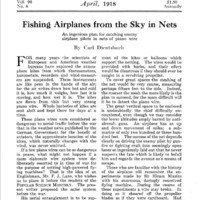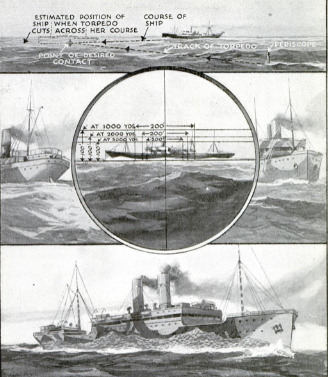-
Title (Dublin Core)
-
Protective coloring for ships
-
Article Title and/or Image Caption (Dublin Core)
-
Hiding Ships with Paint. How protective coloring causes Fritz much waste of torpedoes. It is camouflage at its best
-
Caption: The first illustration shows how closely related the problems of a submarine commander are to those of a duck hunter. He must estimate the speed and course of his target and shoot enough ahead to allow for them. The centre picture shows the appearance of a ship at 2,000 yards, seen through the periscope of a submarine under ideal conditions. The range is determined by the height of the smokestack above the waterline. The two side illustrations are examples of the way the camoufleur changes the light and shade on the hulls, funnels, etc., of vessels, thereby confusing an observer both as to the length of the ship and the angle of her approach or departure. The ordinarily high lights are toned down, and the naturally dull portions are thrown up by painting them in bright colors. At the bottom is seen a complete camouflaged boat, and one that was painted by a master-hand. The whole idea is to give the impression of a sinking ship, and to merge the ship proper into the background. It will be noticed that the dark shaded patches on the hull would convey, at a distance, the impression of a funnel and waterlogged hull, while the sham "sea" merges into the real sea and makes it appear that the alleged steamer is in a sinking condition. This particular instance is a most ingenious one. A more common one is to paint the hull of a smaller vessel of radically different dimensions on the hull of the boat, or to "paint off" the stern and raise up the apparent waterline.
-
extracted text (Extract Text)
-
THE gun afloat, whether upon a naval
| craft or an armed merchantman,
drives the submarine to cover be-
neath the waves when it approaches its
prey close enough to discharge the tor-
pedo. The U-boat commander must,
therefore, keep track of his moving target.
At best, a periscope is a poor substitute
for the naked eye or the binocular vision
‘made possible by good field glasses. The
periscope is one-eyed, and this entails very
definite and unsatisfactory limitations.
These facts must be kept in mind in
order to evaluate the real purpose of ma-
rine camouflage.
Marine camouflage differs radically
from camouflage ashore where the charac-
ter of the background facilitates conceal-
ment. It is a simple thing to cloak a gun
with a sereen of foliage or to motte it
with paint 20 that its contours disappear.
The ship afloat, except through the
agency of a smoke screen, cannot veil its
identity. Under certain’ conditions of
light, the vessel stands vividly silhou-
etted against the sky, and even when the
atmospheric contrast is not so sharp, the
ship can be seen rather distinctly though
painted a single tone of gray.
Atmospheric gray and paint-brush gray
are two fundamentally different things so
far as vision or visibility is concerned.
The latter is the product principally of
black and white pigments, while the at-
mospheric gray is a vibratory effect re-
sulting from the movement of red, green,
and violet rays of light. The quality of
this gray alters from hour to hour as one
or the other of these chromatic rays pre-
dominates, and, manifestly, no single
pigmentary gray could accommodate
itself to these changes. Finally, the
character of a ship is indicated by her
body form and her upper works—details
that are emphasized by high lights and
strongly contrasting shadows.
The submarine in the barred zones
seeks to close in upon its quarry during
the dusk of early morning, or the close of
day or after nightfall, especially if the
moon helps to make the enemy craft
discernible. The camoufleur therefore
tries to reduce the visibility of vessels
during the periods of dim or half light,
and, curiously enough, the more scien:
tific of these men employ really vivid
coloring for the purpose. They paint
their ships with apparently meaningless
splotches of strong pink, blue, and green.
‘The patches become prominent agreeably
to the predominating light ray at the
time, and serve to obliterate those famil-
iar details or forms for which the observer
looks. Not only that, but normally
shaded areas are purposely painted light,
and the visual effect is flat and confusing.
‘There is dazzle and loss of definition in
fairly strong light, and, during periods of
twilight, atmospheric vibration induces a
gray tone that is so nearly akin to the sea
background that craft painted in this
‘marked fashion actually become invisible
at a mile!
Upon the field of a periscope there are
a number of horizontal lines as well as
vertical ones. The horizontal lines are
spaced to represent a prescribed height at
distances say of 1,000, 2.000, or 3,000
yards, while the vertical lines are spaced
to indicate definite intervals at those
different distances 50 as to determine the
speed of a vessel pasing across them.
The U-boat commander, in order to
launch his torpedo with a fair chance of
hitting his target, must know how far off
the enemy ship is, whether her course is
bringing her closer or taking her away,
and approximately how fast she is moving.
With these factors fairly gaged, the tor-
pedo is pointed far enough ahead of the
target to allow for its time of fight and
the advance of the enemy craft.
The commander of the submarine must
also be able to measure the height of his
quarry from her true waterline to the top
of her smokestack, which is a reasonably
constant figure in the run of commercial
freighters, and may be pretty accurately
estimated in the, cases of other larger
merchant ships or well-known types of
naval vessels. Any” coloring that will
tend to obliterate the actual waterline
or conceal or confuse the top of a
steamer’s smokestack will deceive the ob-
server in his effort to determine the dis-
tance or range of
his target, and,
therefore, throw
him out in calcu-
lating how far
his torpedo must
travel in order to
score. Also, any
coloring that de-
stroys the out-
lines of the ship
and makesit hard
to observe her
movement across
the periscope’s
vertical lines so
as to estimate her
speed, will intro-
duce another ele-
nent of error.
It has been de-
termined by care-
ful investigation
that the eye tires
in the course of a
minute or two
when watching a
moving target
steadily through
a periscope even
in broad day-
light; and the
eye so fatigued becomes
erratic in judging both
range and speed. Itshould
be evident, then, that
marine camouflage as we
have developed it in_this
country is calculated to
hasten visual fatigue and
to so bewilder the U-boat
commander, when he can
see one of our vessels, that
his torpedoes will be likely to go wide of
their mark. We may change the old
adage “To err is human, to forgive
divine” to “To err is human to increase
the error is angelic” in this case.
-
Contributor (Dublin Core)
-
Robert G. Skerrett (writer)
-
Language (Dublin Core)
-
eng
-
Date Issued (Dublin Core)
-
1918-04
-
pages (Bibliographic Ontology)
-
514-516
-
Rights (Dublin Core)
-
Public Domain (Google digitized)
-
References (Dublin Core)
-
U-boat
-
Archived by (Dublin Core)
-
Filippo Valle
-
Alberto Bordignon (Supervisor)
 Popular Science Monthly, v. 92, n. 4, 1918
Popular Science Monthly, v. 92, n. 4, 1918



